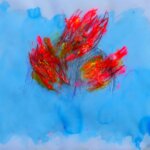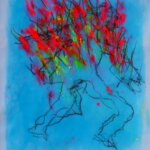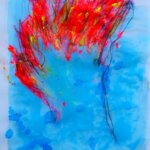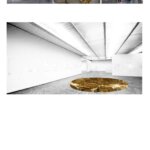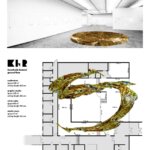THE RIVER. 2024 / Basics
The democratic value of art is not a luxury we can only afford when times are good. It is the bedrock of an open and free society. In art lies the freedom of expression – the freedom to ask bold questions, to expose predetermined truths, and to discover life in all its rawness and beauty. Art is not just expression, it is resistance – it challenges us to look and to act.
Despots and extremists are the first to ban, smash and burn the art. They despise individual freedom, independent, critical thinking and confident behaviour. Diversity and difference are anathema to them. They despise anything that contradicts their ideas. Their actions are guided by the delusion that only their version of their truth counts. They destroy what connects people – including those from different cultures – and what protects humanity and strengthens community.
Chapter 1: THEY This chapter shows five scenes of destruction: a burning house, a burning person and a helping hand in flames. The fourth image – a burning bed – symbolises the loss of safety and security. It raises the question of how to find peace in the face of injustice, violence and destruction. The fifth image is again of a burning person.
These images are deliberately and unexpectedly distributed throughout the exhibition spaces. Instead of a linear narrative, a mosaic of destruction is created. It shows that destructive forces act from different directions, with different dogmas, but are united in the result: They are tearing humanity apart and destroying what is left of it.
These images are a reflection of our reality. They should not only frighten us, but also make us think and challenge us to confront the destructive forces that are constantly trying to divide us.
Chapter 2: The Circle / Installation
The circle symbolises unity, infinity and the eternal cycle of nature. My circle installation is made up of oversized shirts made from rescue blankets that are joined together. The golden side of the blankets, which looks like a shining cry for attention, faces outwards.
This circle creates a space that invites reflection on the connection between people and their own role in the cycle of human communication – on respect, compassion, solidarity and dignity.
Chapter 3: The River / Performance: Dancer and musician
The dancer stands near the centre of the circle. She symbolises the human being’s connection to the cycle of human belonging. By standing up and then moving into the space, drawn by the music, she opens the circle, which becomes the train of dancers: in. As the movement progresses, the train becomes a river flowing through the spaces – the symbol of humanity that promises salvation – and a form of resistance flowing into the spaces of the world.
02/11/2024
